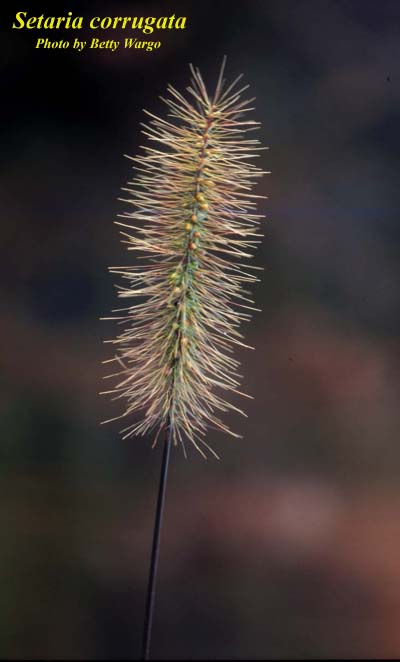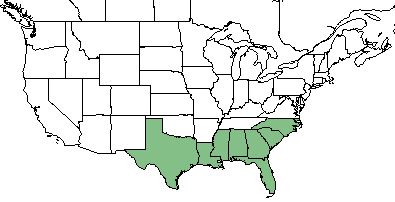Difference between revisions of "Setaria corrugata"
(→Description) |
|||
| Line 25: | Line 25: | ||
==Description== | ==Description== | ||
<!-- Basic life history facts such as annual/perrenial, monoecious/dioecious, root morphology, seed type, etc. --> | <!-- Basic life history facts such as annual/perrenial, monoecious/dioecious, root morphology, seed type, etc. --> | ||
| − | ''S. corrugata'' is an annual graminoid of the ''Poaceae'' family native to North America. <ref name= "USDA Plant Database"> USDA Plant Database [https://plants.usda.gov/core/profile?symbol=SECO4 https://plants.usda.gov/core/profile?symbol=SECO4] </ref> | + | ''S. corrugata'' is an annual graminoid of the ''Poaceae'' family native to North America.<ref name= "USDA Plant Database"> USDA Plant Database [https://plants.usda.gov/core/profile?symbol=SECO4 https://plants.usda.gov/core/profile?symbol=SECO4] </ref> |
==Distribution== | ==Distribution== | ||
Revision as of 12:49, 13 May 2021
Common name: coastal bristlegrass[1]
| Setaria corrugata | |
|---|---|

| |
| Photo by Betty Wargo hosted at Atlas of Florida Plants | |
| Scientific classification | |
| Kingdom: | Plantae |
| Division: | Magnoliophyta - Flowering plants |
| Class: | Liliopsida - Moncots |
| Order: | Poales |
| Family: | Poaceae |
| Genus: | Setaria |
| Species: | S. corrugata |
| Binomial name | |
| Setaria corrugata (Elliott) Schult. | |

| |
| Natural range of Setaria corrugata from USDA NRCS Plants Database. | |
Contents
Taxonomic Notes
Synonyms: Chaetochloa corrugata (Elliott) Scribner
Varieties: none
Description
S. corrugata is an annual graminoid of the Poaceae family native to North America.[1]
Distribution
S. corrugata is found along the southeastern coast of the United States from Texas to North Carolina. [1]
Ecology
Habitat
S. corrugata proliferates in pinelands and disturbed areas. [2] Specimens have been collected from open pineland, coastal hammocks, roadsides, banks of holding ponds, wooded old dune, sandy hardwood clearing, mixed forest, oak woods, longleaf pine sand ridge, wiregrass savanna, bluff by river, mangrove swamp, and open field. [3]
Seed dispersal
This species is thought to be dispersed by wind. [4]
Conservation and Management
Cultivation and restoration
Photo Gallery
References and notes
- ↑ 1.0 1.1 1.2 USDA Plant Database https://plants.usda.gov/core/profile?symbol=SECO4
- ↑ Weakley, A. S. (2015). Flora of the Southern and Mid-Atlantic States. Chapel Hill, NC, University of North Carolina Herbarium.
- ↑ URL: http://herbarium.bio.fsu.edu. Last accessed: June 2018. Collectors: R.K. Godfrey, Loran Anderson, C. Jackson, R. Kral, R. E. Perdue, Richard Houk, R. Kral, A.F. Clewell, D.L. Martin, S. T. Cooper, Gwynn Ramsey, R.S. Mitchell, J. P. Gillespie, D.B. Ward, J. Hunter, F. S. Ward, D. Burch. States and counties: Florida (Leon, Wakulla, Franklin, Santa Rosa, Gadsden, Levy, Brevard, Madison, Citrus, Sarasota, Dixie, Suwannee, Hamilton, Walton, Monroe) Georgia (Thomas)
- ↑ Kirkman, L. Katherine. Unpublished database of seed dispersal mode of plants found in Coastal Plain longleaf pine-grasslands of the Jones Ecological Research Center, Georgia.